
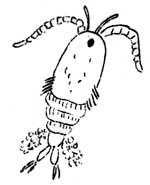
Copepod
x 50
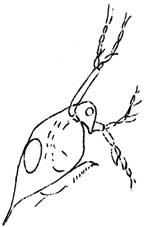
Water Flea x 50 |
The very thought of a visit to a favorite fishing ground has kept
many a tired person from falling into the abyss of hopelessness. No
modern form of relaxation has ever achieved such fame among men as the
visitation to the "Old Fishin' Hole".
It isn't strange that we find a great deal of superstition connected
with fish. In a sense this is a very natural thing, for it hasn't been
until recent years that a study of fish, or fishing, was considered at
all necessary. Even now you can hear of people telling about their
secret hole where trout grow terrifically large due to some almost
supernatural power. That place is usually out of the way and has, as it
seems, no physical connection with the ordinary run of things. It is a
spot dropped from nowhere with such vanishing powers that only the
gifted can find it, meaning of course that such a place is not
determined by the terrain, streams, or anything physical that connect
with it. Yet if such a place were to suddenly become barren there would
be no accounting for it, because that, too, belongs to the "whims of
fate". The correct answer, however, may lie in such an ordinary thing as
the lack of enough oxygen. A fact as common as this may not occur to the
layman because of the fact that fish have enjoyed such an extraordinary
position for so long a time. The wholesale dumping of quantities of fry
into lakes and streams is not the answer to the question of what shall
be done in the development of "good fishing".
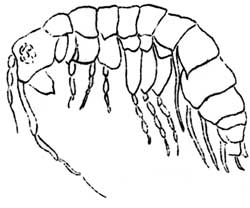
Amphipod
x 10 |
A thorough study of all
the physical qualities both in the water and out is the prerequisite to
the planting of fish. The food habits of the fish should be particularly
noted and then the fishing season opened and closed in accordance with
this. The work of the Internation al Fisheries Commission has proven to
the practical halibut fisherman of the Pacific Northwest that this
method of procedure is the only way. It has saved the industry for those
hardy men of the sea and it can save the ancient and enjoyable sport of
angling from too early a grave in this park.

Colonies of Diatoms
x 100 |
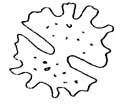
Desmid. |
The ideal fishing hole does not exist as such forever. There are a
thousand details that can change it. The two most disastrous ones are
pollution and logging off of lands. Both of them destroy the breeding
places of our stream fish. In this park both of these conditions exist
only to a minor degree, and can be dismissed without further discussion.
In this article it is not intended that an exhaustive analysis be given
but merely to point out the significant facts in preparation for future
study. It can be readily noted by anyone who has traveled about the park
that the watersheds can not possibly supply the demand for a large
number of fish on a continuation of the present methods. In the first
place the major streams are muddy during their food stages. This
naturally cuts out the sunlight which is such a significant factor in
the growth of plants upon which animal life depends. Second the lakes
are not large nor are they fed by large creeks or streams which are the
natural place for young trout to feed before they migrate to the open
lake. These streams, in so many cases have such a steep gradient that it
offers a decided hazard for the easy migration of the young. Many of
those same breeding grounds are dry for the major part of the season
which also cuts down the amount of food supply that they should be given
to the lakes. A striking example of this is in the phenomenal lack of
mosquitoes during the latter part of the season. While that may be a
benefit to the visitor at large it is a definite lack in the bill of
fare of certain aquatic insects which are in turn food for the trout. A
casual survey of the streams reveals very few of such insects or their
larvae. The caddis flies are most numerous with the mayflies second in
abundance. Where the streams flow slower the dragonflies are predominant
though not numerous enough to form the food supply for any great number
of fish. For the quantity of microscopic life which is so necessary to
maintain an adequate food supply for all the larger form I refer to in a
previous article by Victor Scheffer on "Fish Food" (Nature Notes, Sept.
1932, Vol. X-No. 9) and find that he is not struck by its abundance.
This in itself points to a condition which may be so common to the water
as to limit seriously the maintaining of any large quantity of fish.
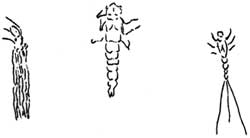
Insect Larvae
(Natural size)
The fish crop as it now stands is not phenomenal. One often hears
from experienced fishermen such phrases as this: "all fished out", or
"caught quite a few but they were all very small", "could see many
swimming around but they were all small", and the like. The best answer
to that frequent question, "Where is the fishing good in the Park?" is
very hard to answer with the number of visitors each taking their share
from the limited supply of the lakes and streams. The demand is
difficult to meet. The best answer will be forthcoming only after an
exact analysis of the situation has been made and strict regulations
made in accordance with these findings. Then and only then can angling
be enjoyed by those who come for that complete relaxation which only
such a sport can give.
Julius Hoverson,
Ranger-naturalist.

